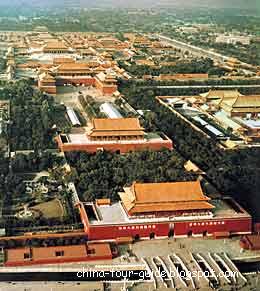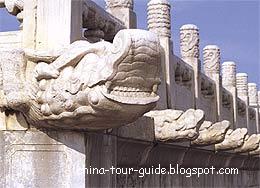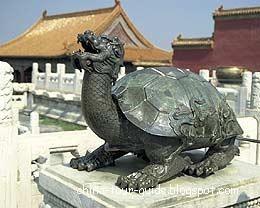The Forbidden City(故宫),Beijing
 The Forbidden City (Imperial Palace) in the heart of Beijing is the largest and most complete imperial palace and ancient building complex in China, and the world at large. Its construction began in 1406 and was completed 14 years later, having a history so far of some 580 years. Twenty-four emperors from the Ming and Qing (1644-1911) dynasties lived and ruled China from there. Most of the buildings in the Forbidden City were rebuilt many times, although they maintained the original architectural style.
The Forbidden City (Imperial Palace) in the heart of Beijing is the largest and most complete imperial palace and ancient building complex in China, and the world at large. Its construction began in 1406 and was completed 14 years later, having a history so far of some 580 years. Twenty-four emperors from the Ming and Qing (1644-1911) dynasties lived and ruled China from there. Most of the buildings in the Forbidden City were rebuilt many times, although they maintained the original architectural style.
The Forbidden City, extending 753 meters from east to west, and 961 meters from north to south, makes a rectangular shape and covers a total area of 720,000 square meters. It consists of several dozen compounds of varying sizes and some 9,900 bays of rooms, with a total floor area of 150,000 square meters. Most of the build ings were built with wood, roofed with yellow glazed tiles and built on blue-and-white stone foundations, looking solemn and brilliant. City walls were 10 meters high, and a 52 meter-wide moat surround the Forbidden City. Three-storied towers are placed at each corner of the wall.
ings were built with wood, roofed with yellow glazed tiles and built on blue-and-white stone foundations, looking solemn and brilliant. City walls were 10 meters high, and a 52 meter-wide moat surround the Forbidden City. Three-storied towers are placed at each corner of the wall.
The building arrangement within the Forbidden City is symmetrical. The Hall of Supreme Harmony, the Hall of Central Harmony and the Hall of Preserving Harmony, which comprise the outer palace, and the H all of Heavenly Purity, the Hall of Union and the Hall of Earthly Tranquility, comprising the inner palace, stand in a line from south to north on the central axis. The 8 km central axis
all of Heavenly Purity, the Hall of Union and the Hall of Earthly Tranquility, comprising the inner palace, stand in a line from south to north on the central axis. The 8 km central axis
The buildings of the Forbidden
 City fully embody the artistic features and style of ancient Chinese palace architecture, and can be called a masterpiece in Chin
City fully embody the artistic features and style of ancient Chinese palace architecture, and can be called a masterpiece in ChinOffice of the Palace Museum Tel: 86-10-85117049
Google Maps,Google Maps coordinate,Only show at Item-Page.
故宫又称“紫禁城”,是明清两代的皇宫,也是世界上最大的宫殿,
 占地72万平方 米(长 960米,宽750米),建筑面积15万平方米,始建于公元1406,1420年建成,是明朝第皇帝朱棣始建,设计者蒯祥(1397—1481年,字廷瑞,苏州人),占地面积78万平方米,用30万民工,共建了14年,有房屋9999间半
占地72万平方 米(长 960米,宽750米),建筑面积15万平方米,始建于公元1406,1420年建成,是明朝第皇帝朱棣始建,设计者蒯祥(1397—1481年,字廷瑞,苏州人),占地面积78万平方米,用30万民工,共建了14年,有房屋9999间半故宫严格地按《周礼·考工记》中“前朝后市,左祖右社”的帝都营建原则建造,其前半部分为外廷,是皇帝朝政场所。建筑庄严、宏伟,特别是太和殿、中和殿和保和殿三大殿,建筑在8米高的三层汉白玉石阶上,以显示封建帝王至高无上的威严,太和殿座落在紫禁城对角线的中心,故宫的设计者认为,不这样不足以显示皇帝的威严,不足以震摄天下。
现在我们参观时都为故宫的宏大而叹服,这一点在参观三大殿时感觉最明显,故宫是目前世界上最大的宫殿。

午门是紫禁城的正门。东西北三面以12米高的城台相连,环抱一个方形广场。当中的正门平时只有皇帝才可以出入,皇帝大婚时皇后可以进一次,殿试考中状元、榜眼、探花的三人可以从此门走出一次。文武大臣按文东武西由两侧门出入。
故宫参观的重点(必看):
1、故宫中路外庭的三大殿(太和殿、中和殿、保和殿)、内庭三大殿(总长近一公里,走下来1个半小时);
2、故宫西路(主要是养心殿,位于西路南端,从雍正开始清代8个皇帝在此居住,参观半小时);
3、珍宝馆(在外东路,收藏有大量的故宫珍宝,票价10元,下午3点半停止售票,细看要3小时)more













No comments:
Post a Comment